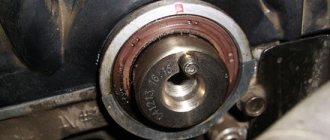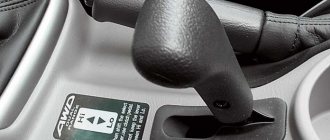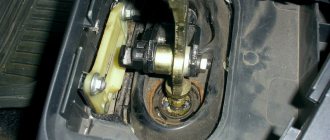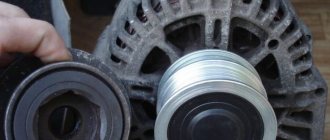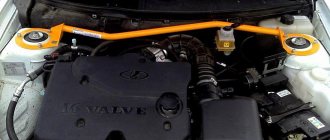Dear readers, today we’ll talk about what an automatic transmission brake band is. Automatic manufacturers are working to improve gearboxes and the comfort of the car owner. One of the purposes of a brake band is to reduce shock when changing gears. We'll talk about this further.
What do you know about the brake band? Write in the comments.
Brake band in automatic transmission
The essence of an automatic transmission is to transmit different rotation speeds to the ring and sun gears.
The advantage of an automatic transmission is that you can change speeds simply by using a small package of friction discs (clutches). Unlike a manual transmission, an automatic transmission also requires a torque converter to operate. During braking at full speed using a fluid coupling, the torque converter “isolates” engine rotation from the gearbox.
Another component of the automatic transmission is the brake band, which briefly blocks the elements of the planetary mechanism. Let's look at this element in more detail. So, in order to understand why a brake band is needed in an automatic transmission, it should be noted that one of the important aspects in the operation of an automatic transmission is the smoothest possible gear shifting.
As a result of turning the clutch and brake band on and off in a certain sequence, the torque from the internal combustion engine is redistributed in the planetary mechanism. This ensures smooth gear shifting.
The automatic transmission brake band is part of the planetary gear control system, as well as friction discs, freewheels, etc. If adjusted incorrectly, the automatic transmission brake band can cause the vehicle to jerk (when engaging first or reverse gear). Such a breakdown can shorten the service life of not only the automatic transmission, but also the internal combustion engine itself.
Purpose of the brake band
Many novice drivers ask me why a brake band is needed in an automatic transmission. The band brake secures the planetary mechanism of the automatic transmission. Self-clamping occurs. And then the tape relaxes. Thanks to this action, the car owner does not feel jolts when changing gears when one gear shifts to another.
Attention! If the transmission limit in the automatic transmission is adjusted incorrectly, the driver will feel a strong jerk when switching to first gear and reverse gear. Prolonged incorrect operation of the brake band will lead to failure of the engine and automatic transmission.
First, let's see where it is located.
- one end of the tape is connected to the machine body;
- the other end is with the servo piston.
The entire clamping procedure is carried out by the pressure force created by the transmission fluid.
- The planetary gear drum is locked when clamped. The latter occurs due to the servo piston. He is pushed by the oil and he clamps the tape.
- The planetary gear stops for a split second.
- The lubricating fluid enters the shutdown cavity. Next, release occurs, during which the drum begins to move in the other direction relative to the braking effect.
- At the same time, gear changes occur. Since the parts of the planetary gear, which restrained the brake mechanism, rotate in the other direction.
- The piston returns to its permanent location and the brake band is released. This process happens in a split second.
Where are they used?
Band brakes are installed on all devices where enhanced clamping torque is required. They are widely used in many areas due to the fact that the design is small, easy to maintain, and at the same time capable of developing sufficient braking force.
Most often they are installed on various types of crane structures, which include tower cranes, winches, and drilling rigs. In addition, band brakes are used on automatic transmissions, lathes, motor vehicles and small tractors.
Purpose of TL
The main task of an automatic transmission is to control the rotation speed of the sun/ring gear, and its main design advantage over its mechanical counterpart is the ability to manipulate speeds through the use of a relatively small set of friction discs.
But such a mechanism turned out to be unable to switch gear ratios without a torque converter, which is a kind of torque converter. It is he who, in the process of braking the car with the gear engaged, disconnects the crankshaft of the power unit from the box using a fluid coupling.
The torque converter is assisted in its operation by the brake band, which is responsible for briefly blocking the operation of the components of the planetary gearbox when changing gears in the automatic transmission. To put it simply, the main function of the TL is to make the transition to another gear as smooth as possible.
This happens due to the sequential switching on/off of the brake band and clutch itself. This process does not start arbitrarily, but according to a certain algorithm. The result of such coordinated operation of the clutch and TL is the redistribution of torque transmitted from the engine to the gearbox through the planetary mechanism.
Thus, the brake band must be considered a component of the planetary mechanism of an automatic transmission, along with the freewheel, clutches and other elements. If the TL tension is adjusted incorrectly, when engaging reverse and first gears, the car will feel strong jerks, which, if not intervened, will inevitably affect the performance of the transmission and, indirectly, the internal combustion engine. This is why an automatic transmission brake band is needed, and that is why its tension must be regularly monitored.
The principle of fastening and operation of the automatic transmission brake band
The brake band is a small part that is fixed to the automatic transmission housing.
Brake band mounting location:
- one end of the tape is fixedly fixed to the automatic transmission housing;
- the second end of the tape is connected to the moving piston of the servo drive.
The principle of fixing the planetary mechanism is similar to the principle of operation of brake shoes. Blocking occurs according to the “self-clamping” principle. All automatic transmission mechanisms are driven by transmission fluid. After liquid enters the servo drive activation cavity, its piston begins to move under the pressure of this liquid.
As a result, the brake band is clamped and, having fixed, blocks the elements of the planetary mechanism for a certain period of time. After a certain time, the planetary gear is unlocked and the transmission fluid flows further into the servo drive shutdown cavity.
The fluid pressure drops, the belt weakens, then the servo piston returns to its original position. The tape unclamps and returns to its free state.
The tape has two ends:
- one is attached to the box body;
- the second end of the tape is connected to the servo piston.
Automatic transmission mechanisms are driven by transmission fluid (oil), and the locking mechanism is no exception. When oil enters the drive cavity, its pressure moves the piston. As the latter moves, the belt is clamped and the planetary gear is fixed. The manipulation is performed for the required period of time.
Then, when the time comes to unlock the planetary gear, the oil enters the shutdown cavity. As the fluid pressure equalizes, the tape weakens, a special return spring begins to act on the piston, and it returns to its original state. The brake band is released completely.
Operating principle of the system
The ends of the brake band are secured:
- motionless on the automatic transmission housing;
- on the movable servo piston.
Schematic illustration of the locking mechanism
When transmission fluid is supplied to the drive activation cavity, the piston begins to move under the influence of oil pressure. After clamping the brake band, the elements of the planetary gear are fixed. The blocking continues for the required time.
As soon as it becomes necessary to unlock the planetary system drum, oil begins to flow into the servo drive shut-off cavity. After equalizing the pressure in the two circuits, the brake band begins to weaken its impact. The return spring acts on the piston, and it takes its original position. The brake band goes into a free state.
Features of operation
Typically, the tape is made from a flexible metal alloy and consists of many strips of it. The metal, despite its flexibility, is quite strong and can withstand high loads of abrasion and tearing. To make the belt more durable and reliable, a friction coating is applied to its inner part at the factory.
Appearance of the brake band:
Operation of an automatic transmission leads to gradual wear of both the friction coating and the metal of the belt itself. Therefore, after a certain mileage, it may become necessary to replace it. On sale you can find both tapes supplied separately and equipped with tension bolts; It is advisable to purchase the tapes in the latter version. This is what the bolt looks like:
To the right of the screw you can see an adjusting pin with a lock nut, which may also be needed when adjusting the tape. The installation location of the tension bolts varies depending on the company that produced the automatic transmission: they can be located both inside the box and on its outside.
Types of brake bands
Did you know that there are three types of band brakes. These types are given in the table, as well as their characteristics.
| Type LT | Characteristic |
| LAT 2 | This tape will operate at a pressure of no more than 5 MPa. Withstands friction temperatures up to 350 degrees. Used in tropical countries. |
| EM-K | This tape will operate at a pressure of no more than 3 MPa. Withstands friction temperatures up to 250 degrees. Used in countries with dry climates. |
| EM-1 | This type is used in various countries. Temperature characteristics – from – 60 to + 250. This is a rolled type of tape. |
The band brake for automatic transmission consists of elastic strips. They are manufactured at the manufacturing plant and undergo rigorous testing. Such tests include:
- tensile test. Strength and reliability are determined;
- flexibility test;
- to counteract abrasion.
Only after passing all these tests “excellently” can the band brake be allowed to be installed on an automatic machine. But no matter how durable it is or made of a flexible and indelible metal alloy, if the automatic transmission is used incorrectly, the vehicle will quickly become unusable.
Summing
The device is represented by two ends of the tape connected to a stopper for braking on the side where the rotating axis is located. The arms or lengths of the levers on which the force acts are proportional to the axis of movement. They can be both different and equal in size. If the arms are made equal, then such an indicator as the braking torque does not depend at all on the direction in which the pulley rotates.
The summing band brake is most often used in devices where a stable fixing torque is needed during reverse and forward rotation of the shaft. For example, in industrial machines where swing movement occurs. To create a certain braking torque in this type of device, greater force is required than in the simplest band brake.
Operating an automatic transmission with a brake band
Operating the vehicle with an automatic transmission gradually wears out the mechanism. If a driver likes to drive in urban conditions, it means that he often has to brake at intersections and pedestrian crossings. Frequent braking will lead to rapid wear of the friction and metal layer.
If you buy a new tape, pay attention to the presence of bolts in the kit. They are usually sold together with the TL. It is also advisable to replace these screws together with the gear shift braking mechanism.
Attention! The bolt heads are protected from corrosion and any exposure to moisture. Using one of the bolts of the kit, the driver can adjust the tension of the TL. This makes the work easier, since there is no need to climb into the machine itself and dismantle the casing.
Typically, all this work on adjusting and replacing the transmission fluid is carried out after changing the transmission fluid or after adding oil to the automatic transmission. No matter how much you would like to, you will have to turn the TL adjustment bolt so that the car does not jerk when changing speeds. For your comfort.
How does the operation of an automatic transmission affect the brake band?
The brake band also consists of many elastic strips made of a metal alloy that is flexible and sufficiently resistant to mechanical stress. A friction coating is applied to its inner part, which makes the tape more reliable and durable.
During operation of the automatic transmission, the metal strips and friction coating of the brake band wear out, resulting in deterioration of fixation. Consequently, the band ceases to perform its functions and requires replacement, and it needs to be replaced with a complete set, that is, a brake band with tension bolts.
The installation of tension bolts can be either outside the automatic transmission or inside the box, which will depend on its design features. Advantages of internal and external bolt placement:
- the bolt head is not subject to contamination and corrosion (internal placement);
- adjustment of the brake band tension is carried out without dismantling the automatic transmission casing (external location);
- Self-tensioning of the brake band without visiting a service center (external location).
Problems with automatic transmission belt and their symptoms
Various malfunctions can occur in the planetary mechanism fixation unit, leading to abnormal behavior of the car and breakdown of the entire box:
- wear of the friction layer of the belt. In this case, the planetary unit is not completely blocked; when switching, the driver feels a “kick” of the box. In addition, a grinding noise may be heard from the automatic transmission;
- damage to the piston cuffs (breakage, physical wear). The tape completely loses its blocking ability, and the box jerks with each gear ratio change;
- piston rod failure due to mechanical damage. The piston breaks up into fragments that get into the transmission fluid and other automatic transmission components. The oil becomes contaminated with metal particles, which act on other parts of the transmission as an aggressive abrasive, and large debris can themselves damage or jam parts of the automatic transmission. Even a short trip with such a gearbox can permanently disable it, which will lead to an expensive overhaul of the automatic transmission or an equally expensive replacement.
Occasionally there are cases when the tape “wedges” the moving elements of the box. This occurs if the opening cavity of the servo drive is dirty or the spring is worn out. A characteristic sign of a problem is that the car refuses to start moving, or, for example, does not work in reverse gear.
Reasons for incorrect operation and adjustment of the automatic transmission brake band
During operation of a vehicle's automatic transmission, malfunctions may occur related to the planetary gear fixation unit.
Causes and effects:
- Damage or wear of the friction layer of the brake band, leading to incomplete blocking of the planetary mechanism. When changing gears, shocks and even grinding noises are felt in the automatic transmission;
- Breakage or other damage to the servo piston cuff. In this case, the brake band is not able to block the planetary assembly. Each change in gear ratio is accompanied by jerks from the automatic transmission;
- Damage to the servo piston rod. In the event of mechanical damage, the piston is destroyed, as a result of which its fragments are carried in the working fluid, end up in different automatic transmission components and can damage them. If the problem is not corrected in time, the box may fail;
- Wear or damage to the spring, contamination of the opening cavity of the servo drive. In this case, the brake band will “wedge” the moving parts of the automatic transmission. The car cannot start moving, reverse gear does not work, etc.
However, in some cases, adjusting this tape helps eliminate a number of problems. During the operation of a car equipped with an automatic transmission, malfunctions associated with shifting gears often occur. During switching, shocks or jerks appear in the box itself.
So, with the help of adjusting bolts or studs with locknuts acting on the system levers, the gap distance between the band and the brake drum changes. In other words, the gaps can be compensated, which allows you to get rid of automatic transmission shocks.
Adjustment features:
- the stud with lock nut is tightened with a torque wrench;
- It is important not to overtighten the brake band;
- It may be necessary to dismantle the gearbox pan (if the adjusting bolt is located inside the gearbox housing);
- adjusting the gap using special rods (only some types of automatic transmissions are adjustable).
It is also possible to adjust the automatic transmission brake band without a torque wrench. In this case, the order of adjustment is as follows:
- the car should be on a slight slope;
- to prevent the car from moving on its own, it is necessary to put the handbrake on, while placing a stop or brake shoe under the wheel;
- after that, the car must be removed from the handbrake and checked whether the brake shoe holds it;
- then you need to put the car on the handbrake again, while moving the brake shoe so that it is a few centimeters from the car wheel;
- it is necessary to loosen the locknut to make it easier to tighten the adjusting bolt;
- then you need to tighten the adjusting bolt until it stops lightly;
- Next, you need to remove the car from the handbrake, gradually loosening the adjusting bolt of the brake band until the car starts to roll;
- tighten the adjusting bolt 2-3 turns (the number of turns is determined experimentally until there is complete absence of jerking when shifting gears).
Adjusting the tape
The gap between the band and the brake drum is adjusted by a system of levers on which force is applied through an adjusting pin or screw. If the adjustment is made with a pin, then it is tightened with a torque wrench. The force with which the torsion is carried out is determined by the car manufacturer.
Automatic transmission with stud installed:
The impact on the pin/screw affects the fastening of the belt in the automatic transmission. If the adjustment mechanisms are accessible from the outside, no additional manipulations are required, otherwise the box tray will have to be removed.
Interesting: some types of “automatic machines” are adjusted using special rods of different lengths. The adjustment is made when disassembling the unit, installing the rod of the required length. Sets of rods are produced by manufacturers of such boxes.
The tension should be monitored at the slightest suspicion of a problem with the tape. It is advisable to carry out preventive diagnostics when changing the oil, since in this case, as a rule, the pan is removed, and it is worth taking advantage of this opportunity.
Important: do not over-tighten the tape, this will speed up the wear of both it and the box as a whole.
How to make adjustments in the field, without a torque wrench (it is advisable to do this with two people):
- stand in a place with a slight slope;
- put the car on the handbrake;
- place a cobblestone, brick, or brake shoe under the wheel to hold the car;
- put the brick (shoe) a few centimeters away from the wheel;
- if there is a partner, he must monitor the car and report when it starts moving;
- loosen the locknut of the bolt;
- tighten it, but not all the way - so that there is a slight stop;
- release the handbrake;
- Gradually loosen the belt bolt until the machine begins to roll on its own;
- tighten the screw 2-3 turns.
The required number of revolutions is determined experimentally until the box shocks disappear. This method does not claim to accurately measure the moment of force during adjustment, but will help eliminate the problem with the tape in the field, after which it is advisable to visit a car service for more precise adjustment and verification, or do it yourself, already with a torque wrench.
I consider this method of adjustment to be the most correct, so as not to catch a small tightening torque; everyone who disagrees (and those who want to get smart) with this, please do not poke, etc.
the need to properly adjust the tape arose after fiddling with kick 1-2, I also noticed shocks at 2-3 (this was before the washers were added)
you need a 14 socket, a small ratchet with a long extension, and a 30 a torx, and the most important thing is a brick! preferably red, we put the car on a small hill, on the handbrake, put a brick and be sure to check that when the handbrake is released, the brick will hold the car. Next, we put honey mushrooms on the handbrake + neutral in the automatic transmission, place a brick at a small distance of 2-3 cm so that the car can roll a little (if you do it with two people, then you can finally not worry about it) loosen the lock nut - leave the key in place, insert a Torx inside and start tightening ! until it stops slightly - well, pull it up a little - then release the handbrake and the car should stand still! then we begin to loosen the adjustment until the car rolls (this is when the drum is released), from this moment we count 2.5 turns (unscrew it) after holding the torx we lock the lock nut and that’s it, individual adjustment is possible i.e. 2 or 3 turns
Signs of brake band wear
If the transmission line of the automatic transmission is worn out, then you will observe the following symptoms:
- Grinding and jerking indicate destruction of the friction layer. In this case, the planetary gear set is not completely clamped and blocked;
- jerks after each gear change or change in the position of the gear selector from “Forward” to “Reverse”, or vice versa. These symptoms indicate destruction of the servo piston cuff;
- If the servo drive rod is damaged, its destruction is not noticeable at first. Only later, when the wear products of the metal mechanism get into the filter and other parts of the automatic transmission, will the driver notice that the automatic falls into the emergency gang or does not want to shift. Ignoring the problem for too long will lead to a major overhaul of the automatic transmission. This is why it is so important to do annual maintenance on your machine;
- destruction or stretching of the spring will lead to the fact that the reverse gear will not work in the automatic transmission. And the tape itself will jam when switching.
To avoid the problems listed above, it is important to pay close attention to each part of the automatic transmission and respond to any abnormal twitching or jolting of the machine.
Adjustment procedure
Adjusting the TL is not as easy as it seems at first. You need to know a number of specific subtleties. Therefore, if you have never adjusted the brake band on an automatic transmission, then invite a friend who understands this topic. Then, you can begin the procedure.
Tools you will need:
- torque wrench;
- wrenches to remove the pan. Since on some automatic machines the adjusting bolts may be located inside the automatic transmission. To get into it, you will need to drain the transmission fluid.
Because there are machines in which the gaps are adjusted using rods. Adjustment is carried out by selecting the desired length of each rod. And these rods are located inside the gearbox housing and are adjusted by experienced mechanics during an oil change.
Attention! I recommend making adjustments after each lubricant change if you have the automatic transmission described above.
You will find what force to apply to tighten the rod in the manual for operating the machine. I do not advise exceeding the efforts indicated in the manual, and I also do not advise tightening the bolt with an eye to the future. The brake mechanism may fail due to overtightening.
If you do not have a torque wrench, you can tighten it by placing the vehicle on a hillside. Be sure to take a partner.
The process is as follows:
- Place the vehicle on a slope. Put the handbrake on
- Place brake shoes under the wheels to prevent the car from rolling.
- Move the shoes slightly forward from the wheels.
- Your partner should notify you when the car starts moving.
- Loosen the locknut of the screw.
- Tighten the bolt a little until it stops. Don't do it too hard.
- Remove the car from the parking brake.
- Loosen the bolt securing the vehicle until the vehicle rolls on its own.
- Replace the shoes and tighten the bolt two turns.
Now you will need to get into the car and ride it. If the tremors disappear, then you did everything right. If not, then the procedure should be repeated.
The subtleties of adjusting the tension yourself
The subtleties of adjusting the brake band adjustment bolt lie in the correct calculation of revolutions, if the brake belt has not been replaced, and the adjustment procedure is carried out on a mechanism that is already somewhat worn out. A precisely adjusted automatic transmission brake band prevents premature failure of clutches and gas turbine engines.
Let's look at an example using the A4LD and 4R44E machines.
- On these automatic transmissions, the bolt fit does not exceed 7 mm. The stock of the rod until it hits the wall is calculated using the following formula: 7 – 2.5 = 4.5 mm. This is the distance from the end of the bolt to the wall. Where 2.5 mm is the piston stroke, which was taken from 2 turns of the screw with a pitch of 1.25 mm.
- We remember the thickness of the friction layer. It is no more than 1 mm. This is what the manufacturer sets.
- Calculate the circumference of the working surface of the tape after taking the first measurements. We use the formula 2nR. It turns out 2x3.14x1. According to the formula, the following figure comes out - 6.28 mm. It means the difference between a complete friction layer and one worn down to 0 mm.
- Now let's find out when the piston hits the wall. This calculation corresponds to the formula 2x3.14x0.72. The last figure is the wear of the friction layer in mm. And the equation in this case will indicate 4.52 mm.
From these calculations we can conclude that if the layer is erased by 0.72 mm, then the rod will rest against the wall and there will be nowhere to tighten it. In this case, you will need to install a new automatic transmission transmission.
Internal placement of screws has a number of advantages:
- they do not corrode or become dirty;
- Adjustment of the belt can be done without dismantling the automatic transmission casing.
The latter is also important because the belt tension can be adjusted independently, without wasting time and money on expensive car service services.
The tension should be checked and adjusted not only after replacing the belt, but also in general after any repair and service operations on the automatic transmission, including topping up and changing the oil. If the box begins to “kick” and jerk, you should also check the belt tension.
see also
Comments 171
I have a Cefir A33. I tried your method. put it on a small hill. Apparently it hasn’t been regulated even once for 20 years. everything is rusty. Somehow unscrew the lock nut. Holding a 30mm Torx inserted into the spark plug wrench, the long tube was unscrewed along the stud and the locknut was unscrewed. then using this locknut, since it sits tightly on the stud, I screwed the stud inwards by six! six turns. and didn’t feel any pressure. I put the netralka on and released the handbrake. the car rolled as if the belt was not stopping the drum. I'm afraid to pull more than 6 revolutions. I unscrewed the pin back to 4. I locked it. I went to test it. the kicks with the original resistor became much less noticeable, but with the resistor in the 18th there was a slight kick only from 2 to 3. And switching 1 and 2 only in the direction of the arrow began to be determined without stupidity, straight away without a kick. I went for a ride and had a blast. next morning went for a day. and everything returned to normal. not in such a severe form as it was, but less noticeably. but it still kicks again, although weaker, and the box seems to have somehow become more responsive or something. will be an exhalation, I’ll try to screw in another half turn)
oh yeah. mileage I bought it at 210 thousand. and the chain was noisy, but as you know, it starts to hum after 300 thousand. therefore, right now the mileage is under 400 thousand), respectively, if Lyuli with a mileage of 150 thousand writes that he screwed in 3.5 and turned out 2.5 turns, count 1 every 120-170 thousand, so then I just need to screw in the collar
